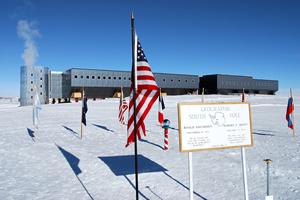The New Amundsen-Scott South Pole Station - The new elevated station is larger and much more sophisticated than anything that has been built at the Pole.
Click on image for full size
Courtesy of Dwight Bohnet/NSF
The New South Pole Station
News story originally written on January 15, 2008
The United States has dedicated a new scientific station at the geographic South Pole. This is the third station the United States has operated at the South Pole since 1957. The new station is called the Amundsen-Scott South Pole Station, named after Roald Amundsen and Robert Falcon Scott. These two explorers were the first humans to reach the South Pole. Amundsen arrived there first, on December 14, 1911. Scott reached the South Pole 35 days later on January 18, 1912.
The United States supports many different scientific research projects in Antarctica. The new station is safe enough to allow scientists to stay at the South Pole year round to conduct research. It will allow scientists to conduct large experiments in areas like astrophysics, environmental chemistry, and seismology. It took 12 years and 925 flights delivering cargo in order to build the station. This new station will allow scientists to continue to work on the scientific field campaigns of the International Polar Year (IPY).
You might also be interested in:

What Will You Find There? If you travel to the South Pole, you will find the continent of Antarctica surrounded by the Southern Ocean. The geographic South Pole is marked by a large sign that scientists
...more
Scientists have learned that Mount Hood, Oregon's tallest mountain, has erupted in the past due to the mixing of two different types of magma. Adam Kent, a geologist at Oregon State University, says this
...more
The Earth's mantle is a rocky, solid shell that is between the Earth's crust and the outer core. The mantle is made up of many different reservoirs that have different chemical compositions. Scientists
...more
Some faults look strong and like they wouldn’t cause an earthquake. But it turns out that they can slip and slide like weak faults causing earthquakes. Scientists have been looking at one of these faults
...more
The sun goes through cycles that last approximately 11 years. These solar cycle include phases with more magnetic activity, sunspots, and solar flares. They also include phases with less activity. The
...more
Studying tree rings doesn't only tell us the age of that tree. Tree rings also show what climate was like while the tree was alive. This means that tree rings can tell us about climates of the past. Two
...more
Earth's first life form may have developed between the layers of a chunk of mica sitting like a multilayered sandwich in primordial waters, according to a new hypothesis. The mica hypothesis, which was
...more















